16 January 2020
The following relates to comments made here
When he brought his “concerns” to us we reviewed his online activity, including his Facebook page. We found this:

Then we found this:

We noticed that the slightly smaller piece was two and a half times heavier that the larger piece. This disparity is outside the parameters of variation for the specific gravity of ambergris. He has referred to the smaller brown piece in his Etsy store as “dry and dusty” lending more disparity. Then we found this:


13 kgs of water has a volume of 13 litres. An item weighing 13 kgs needs to be 13 litres or more to float. A volume of rock weighs about twice that of water. Therefore 13 kgs of rock would have a volume of about 6.5 litres. We estimate the above item is about 6 -7 litres in volume. Below is a piece of authentic ambergris of medium density and of about the same volume. It is about a quarter of the weight.

Then we found this:

And this:

And this:

This:

This:


And this:

Then we found this:


And this:


And this:

And this:

Ambergris does not turn to stone. This is a fiction created by a few rogue traders who want to sell their rocks as ambergris.
Ambergris Beware does not identify ambergris. But it does identify ambergris fraud. If someone were to suggest that the majority of the material displayed in Duncan Harold Payne photographs on Facebook, and elsewhere, are most likely to be a mix of pumice, sandstone and clay then we would agree to that.
Ambergris Beware obtained a copy of the letter to the New Zealand Ministry of Foreign Affairs and Trade referred to in Duncan Harold Payne’s comment. It makes compelling reading and perhaps provides an insight to his mind. The letter is below:




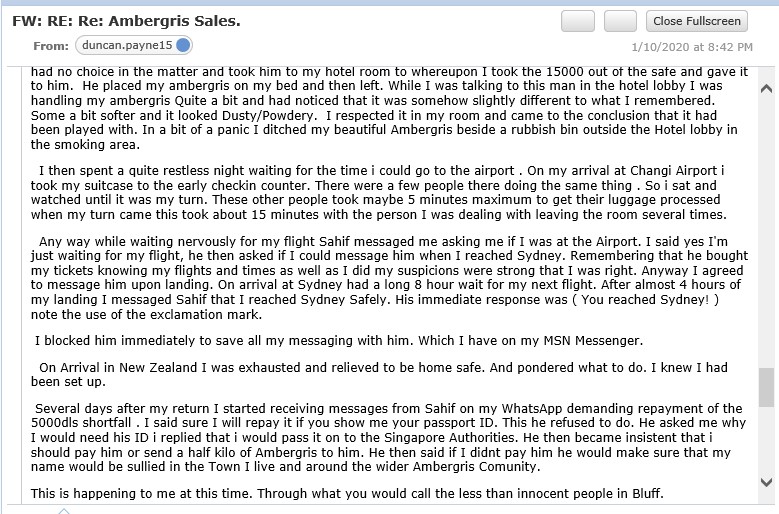
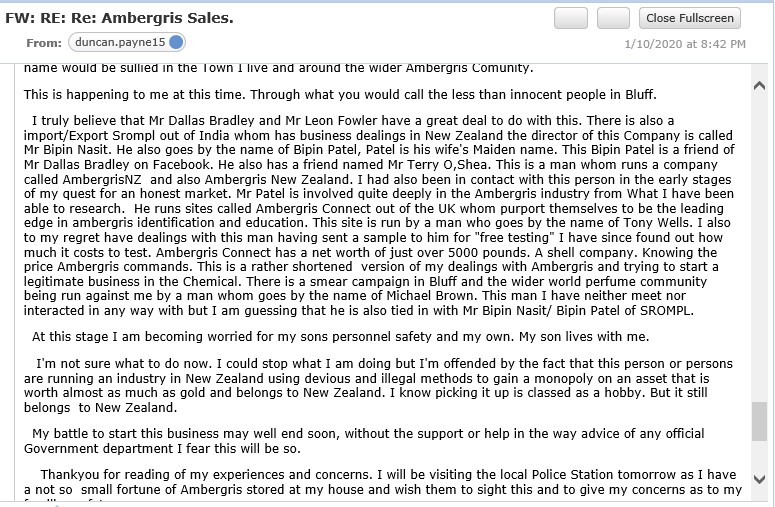

There are probably only a few scammers that would try and involve a Cabinet Minister and a Prime Minister in their scam (yes, he sent a copy to the NZ PM). It will be interesting to see how that goes for him.


Duncan Harold Payne promotes his scam product on Facebook but attempts to sell it via his Etsy store called – Southern Ocean Ambergris and Ambergris 45 South. Do not buy anything from this man.
Update – 21 January 2020. Recently Duncan Harold Payne announced his latest Etsy sale on his Facebook page. Ambergris Beware will hazard a prediction. We predict that Duncan Harold Payne will be arrested and charged in coming weeks with fraud relating to the sale of a 7 gram piece of fake ambergris (pumice) to an undisclosed buyer in Auckland NZ on or about 16 January 2020.

Duncan Harold Payne’s latest victim or … evidence? Watch this space.
Update – 23 January. Today this post (below) appeared on Duncan Harold Payne’s Facebook page. It is dated 3 January. Why did it take 20 days to appear?

Here is the answer. The network of Ambergris Connect and their Facebook Group (FAPG) is vast. It comprises many from India, Pakistan S E Asia and the Middle East. This potentially provides a vast pool of identities. The network is also quite sophisticated in the way it employs deception. The identities support each other, creating “friends” and “likes” on Facebook and providing fake reviews on Ebay, Amazon etc. This helps create a false appearance of validity. The network knows how algorithms work with institutions like Facebook, Google etc. The primary factors for Facebook’s algorithms is age of a page (how long its been there) and number of “Friends” and “Likes”. As with Google, Ebay and others Facebook is operated by a robot (they call it an intelligent computer design). When the robot receives a “report” from a page it assesses the validity of the report via the pages age, friends and likes. If it receives many reports and the pages all appear established and include many friends then the robot assesses the reports as valid. There is no person checking the validity of the report, just a robot counting numbers. Scammers know this is how it works and exploit that flaw by collectively controlling the robot with their contrived Facebook pages.
On 3 January Duncan Harold Payne attempted to post a link to our website but was blocked. That was because the extensive network of Ambergris Connect and FAPG had collectively reported our link, resulting in our link being blocked. However recently we sent a private message to a Facebook identity that we believed to be involved with FAPG etc. He is also a primary identity regarding the Singapore fiasco. Within hours our link was unblocked, as a result of the same collective that blocked it. They unblocked it because they noticed that our website included this article on their associate and stooge – Duncan Harold Payne. So who’s controlling what here? Is Facebook controlling its website or is the network of scammers? We are waiting to see if FAPG etc. attempt to block our link again once Duncan Harold Payne is no longer an item.
Update – 24 January. It appears that the Facebook page of Duncan Harold Payne has been removed from Facebook. His posts in others pages also appear to have been deleted. His Etsy listings still remain at present.
In addition to operating a Facebook page under his name, Duncan Harold Payne has also operated a page titled “Southern Ocean Ambergris”. It appears to mainly attempt to reinforce his scamming on his name page. The following material appeared on Facebook around 25 January detailing a response to his Etsy frauds:
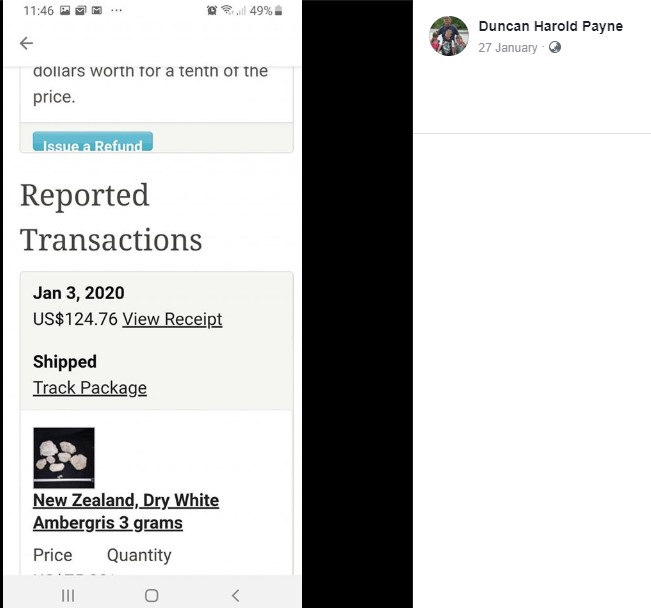



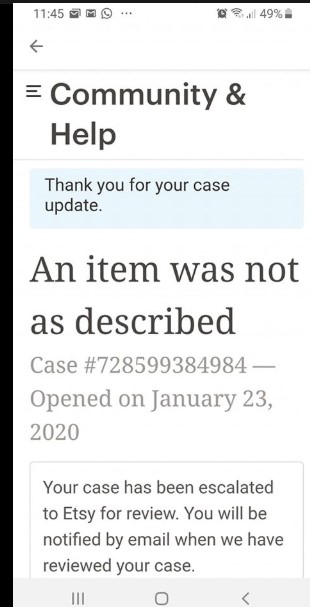
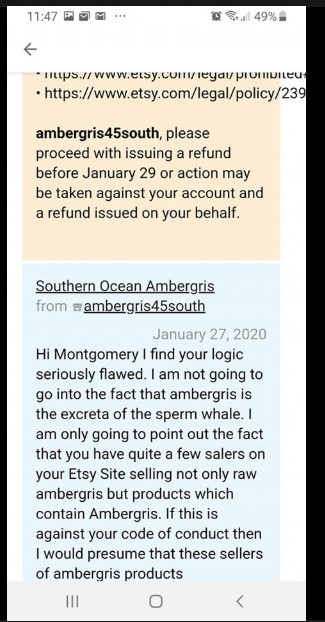
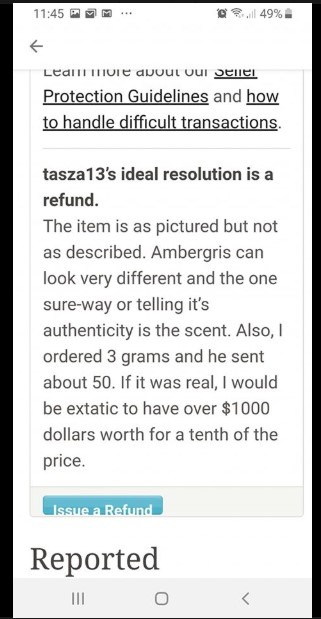



In this case the buyer has paid US$25 a gram and received “about 50” grams rather than the 3 paid for. Over US$1000 of product for US$75 is beyond generous, its absurd. But then Duncan Harold Payne can be seen hack-sawing in half an alleged piece of white ambergris he claims weighs 300 grams here , at his value US$7500.
He has continued displaying his pumice, limestone and other rocks as “ambergris” on this Facebook page but no evidence of attempted fraud via sales has emerged until recently on or about 26 June where upon Duncan Harold Payne listed the following on TradeMe, a New Zealand based sales venue:



Duncan Harold Payne has dusted off an unused (for 10 years) NZ TradeMe account to attempt to fraudulently sell an apparent piece of limestone as “Ambergris Pure White”. However he betrays his actual intent, which is clearly to attempt to sabotage a genuine seller of authentic ambergris also on TradeMe. His rock is nothing like the ambergris displayed on other trading pages.
Notable is his price of NZ$10 a gram, equal to US$6.40 a gram, a far cry from the US$25 he was asking in January.
Duncan Harold Payne’s latest racket – February 2021.

